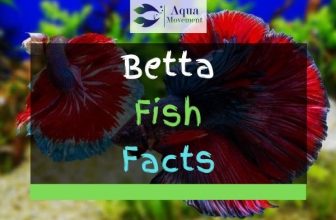21 Types of Tetra Fish (With Pictures)
Discovering the Types of Tetra Fish:
21 Fascinating Species for Beginners
There are hundreds of types of tetra fish under the Characidae family, and when they are together, it’s such a beautiful and relaxing sight as they look like a rainbow in the water.
Tetras’ appearance varies from stripes of colors, spotted, neon colors, and multicolor.
They are generally small in size especially the males, thus they make easy prey for bigger fishes.
If you’re planning to breed tetras, you have to add floating plants in the water like duckweed, amazon frogbit, and water lettuce.
Not only do tetras like hiding in heavy vegetation, but female tetras lay their eggs on these plants and some lay eggs on the roots. These floating plants will likewise make a good shade, making your tetras healthier.
Shade, tank size, proper lighting, consistent temperature, and water condition should always be considered when you’re planning to have tetras at home.
Here are the things you need if you wish to start breeding tetras:
- Filter to keep the tank water sufficiently clean and safe
- Filter cover (like mesh or foam) to protect your tetras from being sucked into a filter
- Adjustable aquarium heater to maintain the right temperature
- Organic matter (like driftwood and floating aquatic plants) to imitate the tetras’ natural home or habitat
- pH testing strips to monitor the pH level; you need a slightly low pH as tetras grow well in slightly acidic water
- Peat bag, which helps lower the pH level when needed and softens the water. Tetras do well in soft or slightly soft water
- Dim lighting to give a dark water effect, imitating the natural habitat of such fish; shade from floating plants will also make it easier to achieve a dark water effect
- Food (tetras are omnivores and generally eat brine shrimp, algae, and small blood worms that may be prepared as is or could be bought as frozen, ready-to-eat, or freeze-dried)
Moreover, the specific methods of taking care of tetras differ based on species or breed.
In the next part of this article, you will be introduced to 21 types of tetra fish with brief information on how to properly manage each.
Table of Contents
Neon Tetra or Paracheirodon innesi

This type of tetra fish originates from Amazon, South America.
Since they are naturally harmonious, they can live with other docile fish. Their colors often come in a beautiful combination of white, red, blue, black, and silver.
- Required tank size
10 gallons for a group of 5 neon tetras, and 55 gallons for a group of 10 to 12 neon tetras
- Maximum length
Up to 1.5 inches long
- Care level and management
Care level is moderate, but you have to prevent nitrate levels from rising. Water temperature should be kept at 70 to 80 °C, with a pH level of 6.5 to 7. You may feed them with pellets, fish flakes, freeze-dried shrimp, and bloodworms.
- Temperament
Peaceful enough even with other species but overly timid, thus should not be kept in a tank with aggressive and larger fishes.
Cardinal Tetra or Paracheirodon axelrodi
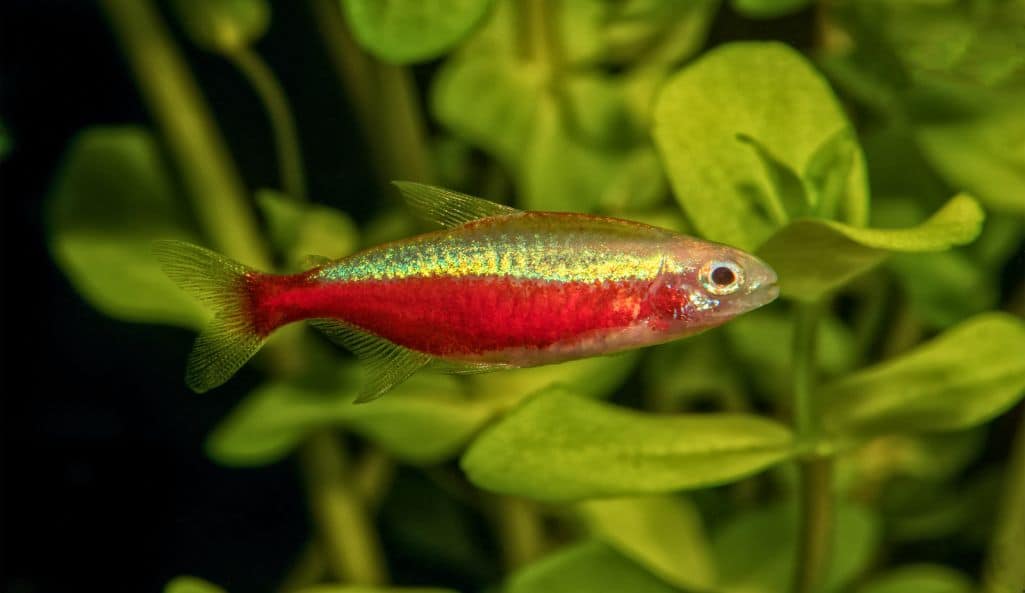
Also known as Red Neon Tetra, the cardinal tetra is among the most popular tetras due to their brilliant colors.
However, they are not easy to breed in home aquariums, and also not the easiest to care for. They come from South America, specifically in Rio Negro and Orinoco.
The neon blue stripe from its nose to tail is very noticeable, combined with red that wonderfully bleeds under the blue stripe into the transparent tail. Their fins are also transparent, and they have a white underbelly.
- Required tank size
At least 15 gallons for a group of 5 to 6
- Maximum length
Up to 1.5 inches
- Care level and management
Care is easy, making the cardinal good for beginners. Water temperature should range from 23 to 27 °C, with a pH level of not greater than 6. They are omnivores and require vitamin-rich food.
It is always better to feed them several times a day in small amounts (something they can finish in about 3 minutes). But, you can also feed them twice a day only with an amount of food that they can finish for 5 minutes.
They love to eat both frozen and live food such as bloodworm flakes, small insects, boiled vegetables, and Daphnia.
- Temperament
Cardinal tetra are very peaceful. Still, adult fish should be removed and transferred to different tanks once eggs are laid since there is a possibility of them eating the eggs or babies.
Serpae Tetra or Hyphessobrycon eques

Commonly known as Blood Tetra or Red Minor Tetra, these come in bright red colors. Like other types of tetra fish, they do well in groups of 5 or more.
One minor disadvantage of keeping this kind in your tank is that they are fin nippers, giving them a bad reputation.
And, one way to avoid this is to have a heavily planted tank to keep them from nipping other fish. Even with that, never mix them with species with flowing fins.
- Required tank size
At least 10 gallons for a group of 5, and 20 gallons for a group of 6 and more
- Maximum length
1.5 to 1.75 inches
- Care level and management
Care level is easy, making it perfect for beginners. Water temperature should be maintained from 22 to 26 °C, with a pH level of 5 to 7.8. They tend to eat various foods which include those that are freeze-dried, live, and in flake form.
- Temperament
They are generally peaceful but have a tendency to nip on the fins of other fish.
Diamond Tetra or Moemkhausia pitteri

These type of tetra fish are very active. Their scales shine and sparkle beautifully like diamonds, hence the name.
They are usually colored green, orange, gold, violet, and silver, but their full color only appears upon reaching full maturity.
- Required tank size
15 to 20 gallons for a group of 5
- Maximum length
Up to 2.3 inches
- Care level and management
Care level is easy. Water temperature should be kept at 24 to 28 °C, while the pH level needs to be about 6 to 7. They eat crustaceans, insects, and worms in the wild but in captivity, they can be fed with flakes or pellets.
- Temperament
Diamond tetra are generally peaceful.
Glowlight Tetra or Hemigrammus erythrozonus

The glowlight originate from South America and are best known as Fire Neon Tetra.
Their semi-transparent bodies emphasize the bright orange or red stripes from their eyes to the base of tails.
- Required tank size
Minimum of 20 gallons for a group of 5
- Maximum length
Up to 1.5 inches
- Care level and management
Care level is easy to moderate. Water temperature should be maintained at 22 to 27 °C, with a pH level of 5.5 to 7. They may feed on live food, frozen food, and flakes.
- Temperament
They’re known for being a peaceful breed. However, they have an anti-predator behavior, which is fin-flicking.
Ember Tetra or Hyphessobrycon amandae

These are known for being among the smallest types of tetra fish. They have an orange, semi-transparent body.
Being with a group makes them feel secure.
- Required tank size
10 to 20 gallons for a group of 5
- Maximum length
Up to 1 inch
- Care level and management
Care level is easy, meaning they’re suited for beginners. Temperature should be from 24 to 28 °C. The pH, on the other hand, must be from 5 to 7. They can be fed with flakes or micro-pellet food.
- Temperament
Like the previous entries in this list, ember tetra have a peaceful temperament.
Pristella Tetra or Pristella maxillaris
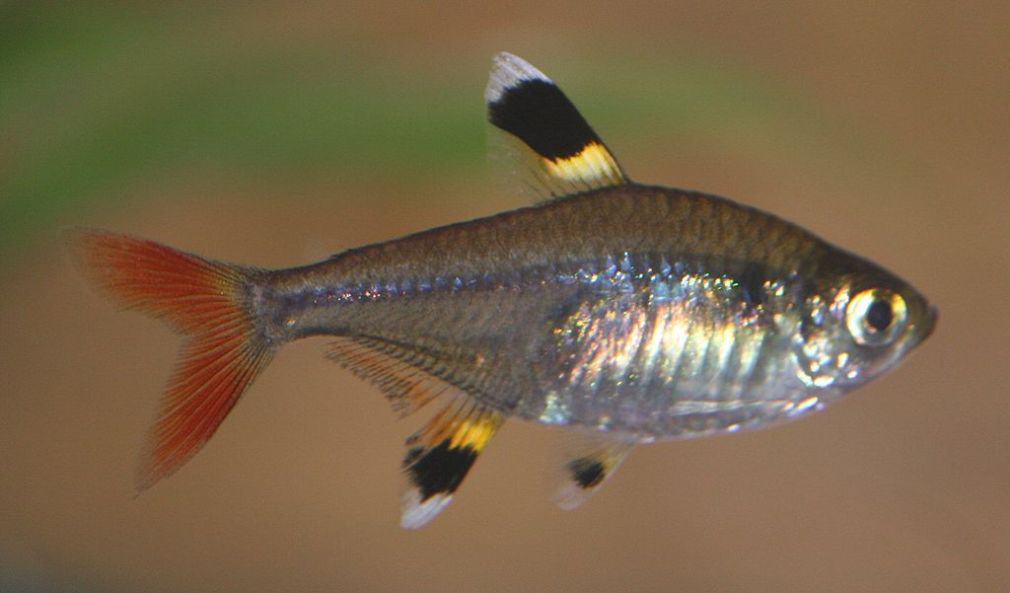
These are also known as X-ray tetra due to their almost-transparent body.
Their color is silvery yellow while the anal and dorsal fins begin with a yellow stripe, then black, and ends with a white tip.
They have an albino version called Albino Pristella Tetra or Golden X-ray Tetra, which have pink spots and pink eyes but are more transparent looking because of the washed-out coloration.
- Required tank size
10 to 20 gallons for a group of 6 or more
- Maximum length
Up to around 2 inches
- Care level and management
They’re hardy and so, they will do fine in a broad range of conditions (both in temperature and pH). This means they’re easy to care for and are a great pick for beginners. They enjoy small fish food, including freeze-dried and frozen varieties.
- Temperament
They’re among the most peaceful species of tetra but become agitated when kept with bigger fish in the same tank.
Bloodfin Tetra or Aphyocharax anisitsi

These are silver bodied with a greenish hue when illuminated with good aquarium lighting. This tetra is somewhat adaptable to a wide range of water parameters.
There are even hobbyists that place them in cold water tanks, though it’s always best to keep the temperature in check.
At times, bloodfin tetra get easily scared so it’s always better to keep them in a group of at least 6 to limit this type of behavior.
These tetras are active and can be often seen nipping at each other.
- Required tank size
20 gallons for a group of at least 6
- Maximum length
Up to 2 inches
- Care level and management
Care level is easy, making the bloodfin a good pick for beginners. Water temperature ranging from 21 to 27 °C should be maintained, with a pH level of 6 to 8.
Bloodfin tetra eat small insects and worms, though they aren’t that picky. You can feed flake food, brine shrimp, dried or frozen fish treats, or bloodworms.
- Temperament
Generally peaceful, they should be kept as small schools, probably a group of 6 to help them keep calm. You also have to watch out for minor fin nipping.
Emperor Tetra or Nematobrycon palmeri

Also called Rainbow Tetra, these type of tetra fish do well in heavily planted tanks. Their sides below the line are dark blue and they have a black line and yellow edges on their proctal fins.
They also have emerald-blue eyes. Aside from the two-tone-bodied emperor, there’s an all-black morph.
- Required tank size
20 to 30 gallons for at least 6 tetras
- Maximum length
Up to 1.5 inches
- Care level and management
Care level is easy. Water temperature should be maintained at 22 to 27 °C, with a pH level of 5 to 8. They can be fed with worms, micro-pellet food, and similar live or thawed foods.
- Temperament
Emperor tetra are peaceful and do well in small groups.
Rummy Nose Tetra or Hemigrammus rhodostomus
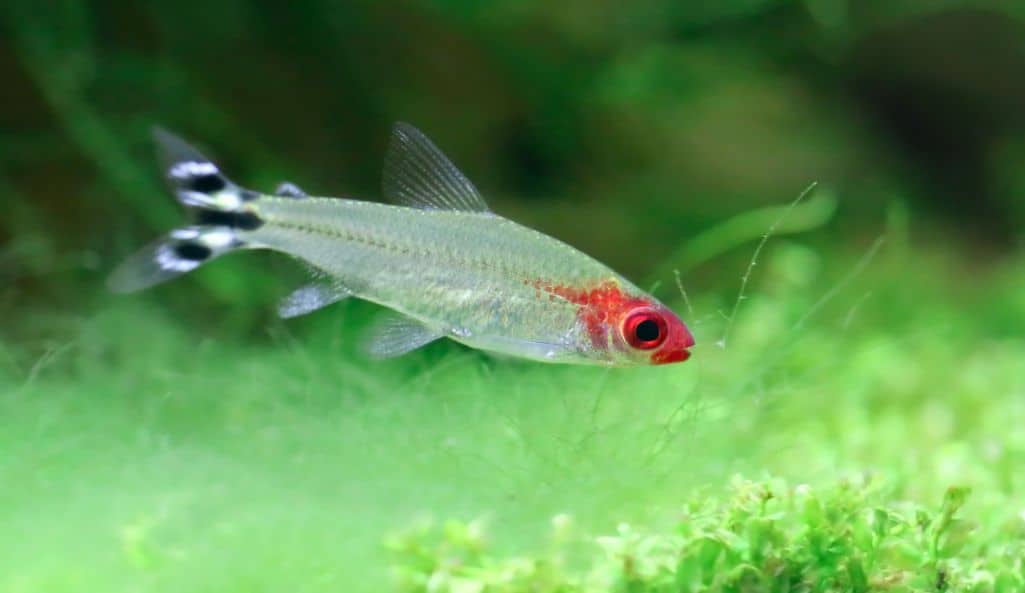
The nose is colored in red that bleeds to the gills. They do best in a small school, like groups of 6 or more.
They like hiding and may feel stressed if there are no hiding places (such as those provided by plants).
- Required tank size
20 gallons for a group of 6
- Maximum length
2 inches
- Care level and management
Care level is easy to moderate. They are extremely sensitive to pH fluctuations so you have to be careful when cleaning and changing the water. Do your best to keep the water at 22 to 27 °C, with a pH level of 5.5 to 7.
- Temperament
Rummy nose tetra are known to be very peaceful.
Black Skirt Tetra or Gymnocorymbus ternetzi
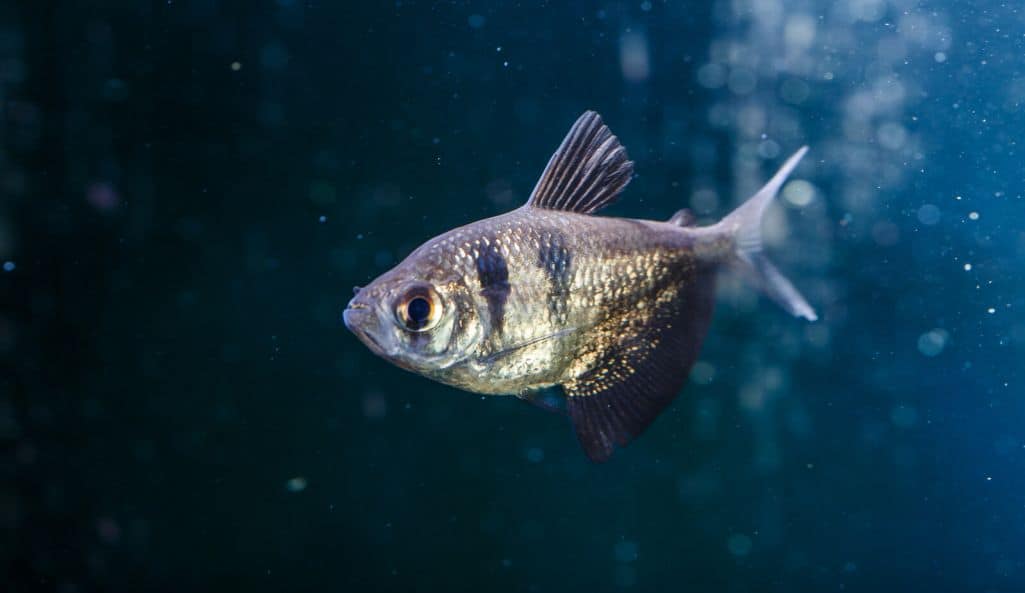
Also known as Black Tetra or Black Widow Tetra, these are very popular with hobbyists.
They have different variations in colors and aren’t very sensitive when it comes to the quality of water.
- Required tank size
20 gallons for every group of 5
- Maximum length
2 inches
- Care level and management
Care level is easy, making black skirt tetra perfect for beginners. Water temperature should be kept at 24 to 27 °C, with a pH level of 6 to 7.5. These can be fed with frozen and freeze-dried food. They also nibble on aquarium plants.
- Temperament
Black skirt tetra are generally peaceful but you need to avoid keeping them with fin nippers in the same tank. And just the same, keep them away from species with larger fins as they are also known to nip fins.
Head and Tail Light Tetra or Hemigrammus ocellifer
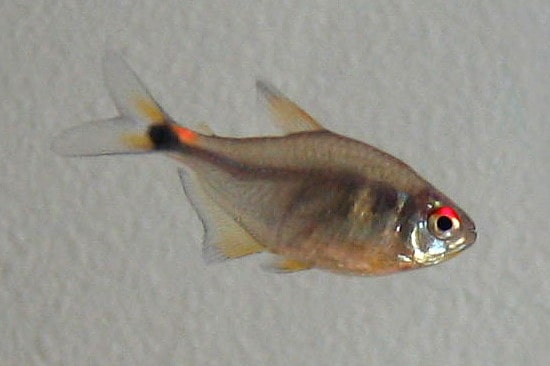
From the name itself, the head, specifically behind the eyes, and tail, as well as the base of the caudal fin, seem to reflect light. This light-reflecting effect can be easily seen if your aquarium has good lighting.
As their natural habitat in the Amazon Basin is slow-moving waters, it would be a great idea to add a mild or slow current in your aquarium.
- Required tank size
Minimum of 20 gallons for every group of 6
- Maximum length
2 inches
- Care level and management
Care level is easy. The water temperature should be maintained at 22 to 27 °C, and with a pH level of 6 to 7.5. The tetra can be fed with a variety of live and frozen food, as well as flakes.
- Temperament
This species is considered peaceful.
Black Neon Tetra or Hyphessobrycon herbertaxelrodi

These came from South America and Brazil. They have a striking yellow-green stripe that runs in the length of the body, emphasizing the black region under.
These type of tetra fish are sensitive to pH and temperature fluctuations. When acclimating this fish to your aquarium tank,
it is better to make the process a little longer, about an hour instead of 15 minutes. Gradually add tank water into the bag every 10 minutes.
- Required tank size
Minimum of 20 gallons
- Maximum length
1.5 inches
- Care level and management
Care level is easy to moderate. Water temperature should always be monitored as well as the pH level and should be kept at 22 to 27 °C with a pH level of 5.5 to 7. They can be fed with frozen food, live food, and flakes.
- Temperament
They’re peaceful and best kept in small schools (groups of 6).
Penguin Tetra or Thayeria boehikei

Also known as Blackline Penguinfish, Hockey Stick Tetra, or Penguinfish, their color ranges from pale to golden and they have a black stripe from gills to the bottom side of the tail, like a penguin.
They are egg scatterers. Females drop hundreds of eggs that hatch within 20 to 24 hours.
- Required tank size
20 to 30 gallons for a group of 6 or more
- Maximum length
Up to 1.2 inches
- Care level and management
Care level is easy. Water temperature should be kept at 22 to 28 °C, with a pH level of 6 to 8. They can be fed with flakes and smaller pellet foods. You should also add brine shrimp, thawed bloodworms, and/or other freshwater preparations.
- Temperament
The penguin tetra are generally peaceful.
Blind Cave Tetra or Astyanax mexicanus

As the name itself implies, these type of tetra fish have no eyes. Well, they are born with eyes but the eyes degenerate and are reabsorbed back inside the body when they are a few weeks old. There are some species with eyes but they are rare to find.
These tetras are totally devoid of pigmentation. They are pink but once they get older, they show luminous colors that change when seen from different angles. Subdued lighting is preferred, like in their natural habitat.
When being introduced to a new aquarium, they tend to nip at other fish but they rarely do it again after learning that they are not food. Often, they also eat eggs of other fish, especially those that end up on the surface.
- Required tank size
Minimum of 20 gallons for just a school of 5
- Maximum length
Up to 3.5 to 4 inches
- Care level and management
Care level is easy. Water temperature should be kept at 20 to 25 °C, with a pH level of 6 to 7.5. They may be fed with flakes, granules, and pellets, as well as frozen and live foods.
- Temperament
The blind cave tetra are a fairly peaceful species.
Black Phantom Tetra or Hyphessobrycon megalopterus
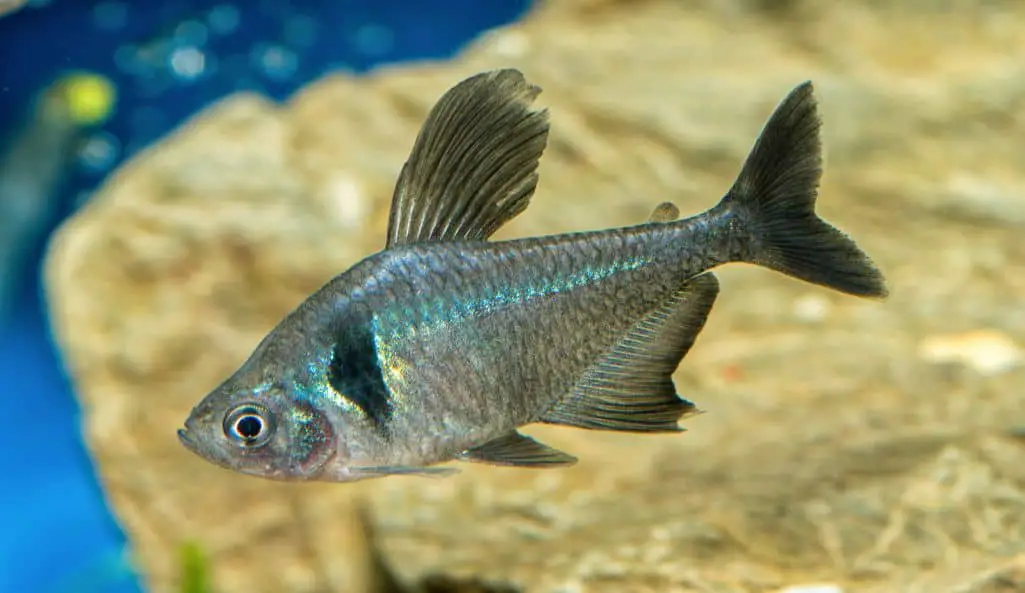
These are light gray, full-bodied tetra with a black diamond-like patch and silver or green outline on both sides of the body.
Males, usually, have darker colors when they are ready to breed or whenever they are trying to protect their territory in the aquarium against other black phantom tetras.
Males may sometimes be seen “sparring” with each other, but it doesn’t cause any significant harm to them.
It’s best to keep them in schools of 6 or more, and they tend to develop a pecking order within the group.
- Required tank size
At least 10 gallons for every group of 6
- Maximum length
Up to 2 inches
- Care level and management
Care level is easy. Water temperature should be maintained at 22 to 27 °C, with a pH level of 6 to 7.5. As omnivores, they welcome all sorts of food. They can be fed with high-quality flakes, as well as foods with higher protein such as brine shrimp and bloodworms.
- Temperament
They’re peaceful but males may become aggressive with other male black phantom tetras during spawning time.
Lemon Tetra or Hyphessobrycon pulchripinnis

Another type of tetra fish, these originate from the Amazon River.
They’re a full-bodied species of tetra, with a body that is transparent and has a golden yellow-orange hue.
- Required tank size
Minimum of 10 gallons for a school of 6, assuming there is nothing else in the tank aside from them
- Maximum length
1.5 to 2 inches
- Care level and management
Care level is easy. Water should be maintained at 21 to 27 °C, with a pH level of 6 to 7.5. They can eat granules, flakes, pellets, live food, and frozen food.
- Temperament
Lemon tetra are fairly peaceful.
Flag Tetra or Hyphessobrycon heterorhabdus
Also from the Amazon, these tetra have a backside that is reddish-brown in color, and their abdomens are silver with a touch of green-olive. They also have a distinct black stripe mark with yellow or green on top.
- Required tank size
At least 15 gallons for a school of 5
- Maximum length
Up to 1.4 inches
- Care level and management
Care level is easy. Water temperature should be maintained at 20 to 26 °C, with a pH level of 5.5 to 7.5. They feed on bloodworms, dried food, Daphnia, Moina, and mosquito larvae.
- Temperament
Flag tetra are known to be very peaceful.
Bleeding Heart Tetra or Hyphessobrycon erythrostigma
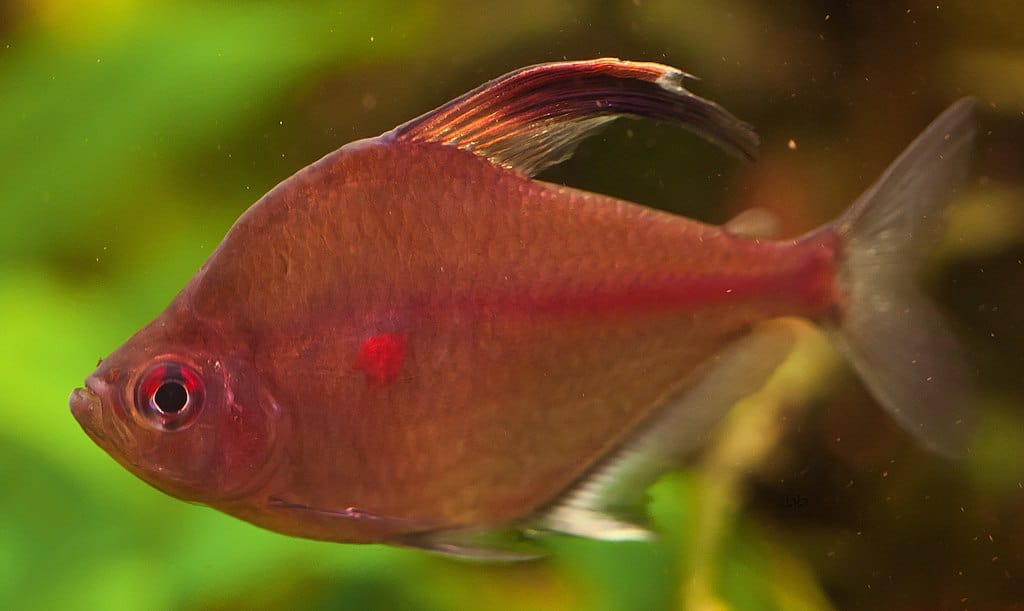
Also known as Red Tipped Tetra or Punto Rojo, these can be easily distinguished because of their small red spot on the sides, near the position of the heart.
They can be a victim of fin nipping if kept alone and mixed with other species. Keeping them as a group of 4 or more will help them feel more secure.
- Required tank size
Minimum of 20 gallons for a group of 4 to 6
- Maximum length
Up to 3 inches
- Care level and management
Care level is easy to moderate. They’re considered a good choice for beginners. Water temperature should be kept at 22 to 27 °C, with a pH level of 6.5 to 7. They can be fed with frozen food, flake food, or live food.
- Temperament
They’re generally peaceful when kept in small numbers.
Buenos Aires Tetra or Hyphessobrycon anisitsi
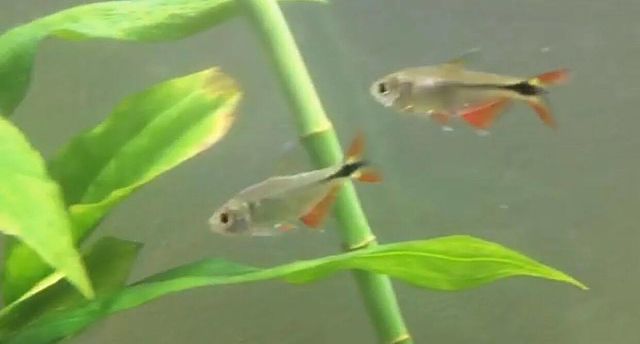
Also referred to as the Diamond Spot Tetra, these originally came from South America, particularly in the ponds of Paraguay and Uruguay.
They are silvery as a whole with flashy neon highlights. The top and bottom of the tail and fins, as well as the pelvic and anal fins, are generally red. There is also an albino type of this tetra but it’s far from common.
Buenos aries tetra are notorious for eating plants so they shouldn’t be the first choice in a planted tank.
- Required tank size
Minimum of 20 gallons for a group of 6
- Maximum length
Up to 3 inches
- Care level and management
Care level is easy. Water temperature should be maintained at 22 to 27 °C, with a pH level of 5.5 to 7. You may feed them with frozen food, flakes, and live food.
- Temperament
They tend to bully smaller fish and can be fin nippers. It’s best to keep them in small schools of 6 to improve your chances of seeing better behavior.
Bucktooth Tetra or Exodon paradoxus

These originated from South America, particularly in the Amazon and Tocantins River basins.
Contradictory to the name, there’s no way that this tetra is a buck-toothed at all, but they eat the scales of other fish so be cautious if you are planning to add fish that have scales in your tank.
This species have a very beautiful color scheme—bright metallic silver with two prominent black spots (one before the tail, and one below the dorsal fin), and yellow fins that end with red tips.
- Required tank size
At least 30 gallons
- Maximum length
2.9 inches
- Care level and management
Care level is easy. Water temperature should be kept at 23 to 28 °C, with a pH level of 5.5 to 7.5. They eat fish scales and small insects in the wild. While in captivity, they can feed on pellets or flakes a few times per day.
- Temperament
They are generally peaceful. However, you have to avoid keeping them with other species as they are known to be lepidophages (they eat the scales of other fish).
If you’ll really insist on combining them with other species, make sure you have a very large tank and keep them well fed so that they won’t be eating scales off of their tank mates. It is okay to keep them with scaleless species though.
Final Words
Those are 21 types of tetra fish that have become popular among beginners and seasoned hobbyists alike.
In general, keep these in mind as you start caring for these fascinating fish:
- Tetras should be kept in groups to promote schooling. Most of them feel stressed when alone with other species, and it makes them calm if they are in school.
- Tetras should not be kept with larger species that are capable of eating them.
- Tetras are omnivores and usually are not picky eaters.
- Most of them survive in soft water with well-maintained temperature and pH level.
- As for their natural habitat, tetras are into dim lights and floating aquatic plants. Aquatic plants serve as hiding spots and provide shade. Some tetras even make these aquatic plants their food, and you will see them nibbling on the leaves.



